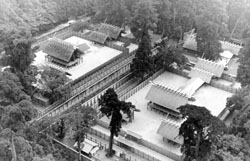There are about 80,000 torii-gated Shinto shrines in Japan, many of them unassuming little roadside structures at which, from time to time, you might see a passerby pause, briefly join his or her hands in prayer and move on, enriched and refreshed in ways an outsider can hardly presume to say.
Among the grander establishments, two in particular stand out as central to the less spontaneous, more official side of Shinto. Though poles apart in terms of time, setting and ethos, they embody a shared aim — that of strengthening the state and its core symbol, a heaven-descended Emperor.
Ise Jingu and Yasukuni Jinja were both born of modernizing, statist revolutions — Ise of a seventh-century palace coup that transformed a primitive scattering of clans into a centrally governed, quasi-Chinese civilization; Yasukuni of the 19th-century Meiji Restoration that turned a languishing feudal anachronism into a quasi-Westernized military and industrial powerhouse.

















With your current subscription plan you can comment on stories. However, before writing your first comment, please create a display name in the Profile section of your subscriber account page.